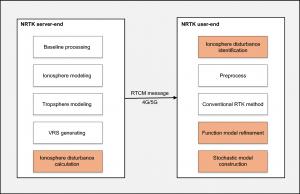Adaptive model shields real-time positioning from ionospheric chaos
GA, UNITED STATES, October 21, 2025 /EINPresswire.com/ -- As solar activity reaches its peak, disruptions in the ionosphere are severely degrading satellite navigation accuracy across the globe. To overcome this, scientists have unveiled a new adaptive Network Real-Time Kinematic (NRTK) positioning method that intelligently counters space weather interference. By combining ionospheric disturbance monitoring with dynamic error modeling, the method stabilizes Global Navigation Satellite System (GNSS) performance even in turbulent atmospheric conditions. Tests using Hong Kong's reference network data revealed that the adaptive approach raised positioning accuracy by more than 40% and boosted the signal-fixing rate from 58% to 84%. The breakthrough offers a powerful step toward uninterrupted, centimeter-level precision during solar storms.
The ionosphere, a charged layer of Earth's upper atmosphere, can fluctuate dramatically under solar radiation, distorting satellite signals vital for navigation and mapping. During solar maxima, these fluctuations cause sudden jumps in Total Electron Content (TEC), triggering ionospheric scintillation that weakens Global Navigation Satellite System (GNSS) positioning reliability. For users relying on centimeter-level accuracy—such as surveyors, engineers, and autonomous systems—these disturbances can mean system downtime and significant losses. Traditional Network Real-Time Kinematic (NRTK) positioning methods assume smooth ionospheric conditions and thus fail during active solar periods. Because of these challenges, researchers have sought adaptive techniques that can perceive and respond to ionospheric dynamics in real time, preserving GNSS stability even in stormy space-weather environments.
A research team from Wuhan University and Guangzhou Hi-Target Navigation Tech Co. Ltd. has developed a pioneering NRTK positioning model capable of maintaining centimeter-level accuracy under intense ionospheric disturbances. The study, published in Satellite Navigation on October 6, 2025, introduces a dual-optimization framework that integrates real-time ionospheric indices with adaptive functional and stochastic models. By learning from disturbance patterns and automatically recalibrating user-side algorithms, the system dramatically enhances GNSS reliability during the ongoing solar cycle peak—offering a key safeguard for positioning technologies in low-latitude regions most vulnerable to ionospheric turbulence.
The innovation centers on leveraging the Rate of Total Electron Content Index (ROTI), a key indicator of ionospheric activity, to dynamically adjust both ionospheric residual estimation and observation weighting. When the system detects disturbances, it automatically reduces the influence of affected satellites and refines error models in real time. Using data from Hong Kong's Continuously Operating Reference Station (CORS) network—one of Asia's most active low-latitude regions—the researchers found that ROTI showed a strong positive correlation (0.91) with ionospheric interpolation errors and a negative correlation (–0.9) with signal-fixing rates.
Compared to conventional NRTK methods, their adaptive "Method B" improved horizontal and vertical positioning accuracy by 37.6% and 41.6%, respectively. Moreover, it achieved a stable 84% average fixing rate, even during equinoctial months when ionospheric scintillation is strongest. The results reveal not just a technical upgrade but a practical solution for real-time navigation across regions frequently affected by solar-induced ionospheric noise.
"Our method essentially teaches GNSS systems to think smarter under stress," said Dr. Xiaodong Ren, senior researcher at Wuhan University and lead author of the study. "By allowing the model to 'sense' and adapt to space-weather disturbances in real time, we've moved beyond static correction systems toward intelligent positioning. This is crucial not only for maintaining accuracy but also for ensuring resilience as solar activity intensifies." He added that this approach could serve as the foundation for next-generation, self-correcting navigation systems that operate reliably under any atmospheric condition.
This adaptive NRTK framework marks a significant leap forward for industries that depend on precise, real-time location data—from autonomous driving and drone surveying to precision agriculture and infrastructure monitoring. By integrating live ionospheric monitoring into everyday positioning workflows, it ensures continuous accuracy even when solar storms strike. Future developments may combine this model with artificial intelligence and multi-constellation GNSS networks to further enhance forecasting and resilience. As Earth moves through one of its most active solar cycles, such innovations will be essential to keeping our navigation, communication, and automation systems firmly on course.
References
DOI
10.1186/s43020-025-00179-4
Original Source URL
https://doi.org/10.1186/s43020-025-00179-4
Funding information
This work was funded by the National Science Fund for Distinguished Young Scholars of China (Grant No. 42425003), the National Natural Science Founda tion of China (Grant No. 42388102, No. 42230104) and the Fundamental Research Funds for the Central Universities (No. 2042025kf0026).
Lucy Wang
BioDesign Research
email us here
Legal Disclaimer:
EIN Presswire provides this news content "as is" without warranty of any kind. We do not accept any responsibility or liability for the accuracy, content, images, videos, licenses, completeness, legality, or reliability of the information contained in this article. If you have any complaints or copyright issues related to this article, kindly contact the author above.

